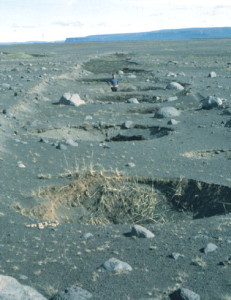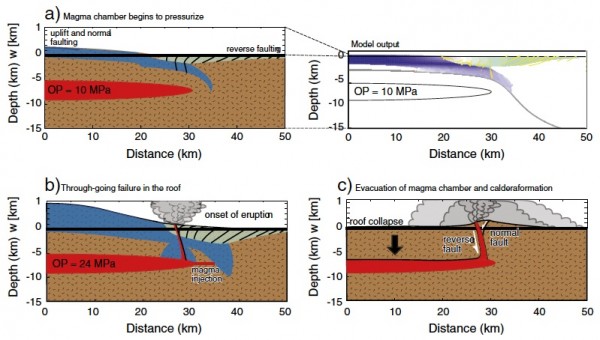Research conducted during the past two decades, which some might describe as the “golden age” of Mars-directed planetary exploration, has taught us a tremendous amount concerning the formation and evolution of the red planet. At the same time, however, scientists’ observations have raised many new questions, and as we continue to explore we learn more every day about exciting new areas such as Mars’ ice ages and climate variations, the role of water, the timing of volcanism, the rate of impact cratering, and many other processes.
Recently, in a study that connects observations ranging in time from the Viking missions in the 1970’s right up to the present, I worked with colleagues from JPL (Laura Kerber, PO ’06) and Brown University (including my former Ph.D. advisor Jim Head) to investigate the formation of unusual polygonal ridge networks on Mars (Figure 1). How do these ridge networks form and what insights, especially into groundwater circulation on Mars, might they therefore provide?
As is often true, the answer is complex: several different mechanisms seem to operate, though all share in common an origin linked to fractures that were later infilled by materials more erosion-resistant than their surroundings. Based on their geologic setting, their spatial correlation (or not) with other chemical and/or hydrological signatures, and their weathering behavior, many polygonal networks appear to have originated as fractures infilled by hydrous mineral deposits, while other networks are more likely fracture systems infilled by magma and/or lava in the near-surface environment. Still other networks may have been infilled by sediments that were later preferentially cemented, rendering them more resistant to regional erosion, but the origin of this feature class remains somewhat enigmatic based on observations available to date.
A great deal remains to be learned, and our initial study makes it clear that as more high resolution data become available new polygonal ridge network examples will continue to be identified, expanding our understanding of these intriguing geologic features. Indeed, as of early 2017 citizen-science volunteers are encouraged to get involved in the search for new examples, with results potentially being used to direct future observations by the HiRISE camera and similar instruments currently in orbit around Mars (see below)!
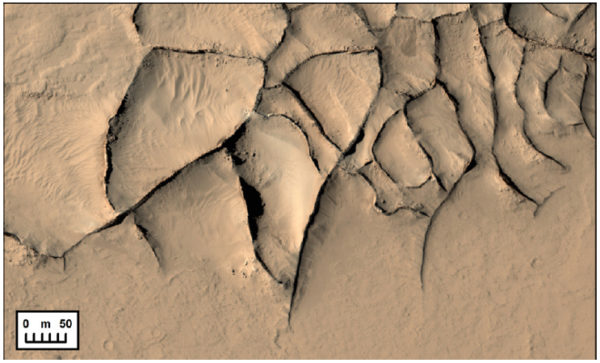
Figure 1: A HiRISE color close-up of a polygonal ridge network in Gordii Dorsum, Mars (ESP_045409_1915).
For more information:
- Kerber, L., J.L. Dickson, J.W. Head, and E.B. Grosfils, Polygonal ridge networks on Mars: Diversity of morphologies and the special case of the Eastern Medusae Fossae Formation, Icarus, 281, 200-219, 2017.
- JPL News article describing current polygonal ridge network results.
- Join in the citizen-science effort to locate new examples of the polygonal ridge network phenomenon.
![Fig 1: For host rock of density 2600 kg/m^3, demonstration that rupture location (small arrows) is invariant for magma densities ranging from 1000-3400 kg/m^3 [for full details, see Figure 6 in Grosfils (2007)]](https://research.pomona.edu/eric-grosfils/files/2015/11/2007Fig-321x600.jpg)
![Fig 2: when buoyancy is treated without correctly integrating it into the complex suite of stresses in the host-reservoir system, significant deformation and faulting is predicted (a), but modeling buoyant stresses as an integral part of the system reveals that it has minimal impact (b). [For full details, see Figure 5 of Gregg et al. (2015)]](https://research.pomona.edu/eric-grosfils/files/2015/11/2015Fig.jpg)
![Fig 3: Viscoelastic model for incremental reservoir pressurization and fault evolution of a supereruption-sized magma reservoir system. [See Figure 10 of Gregg et al. (2012) for full details]](https://research.pomona.edu/eric-grosfils/files/2015/11/2012Fig10-600x344.jpg)
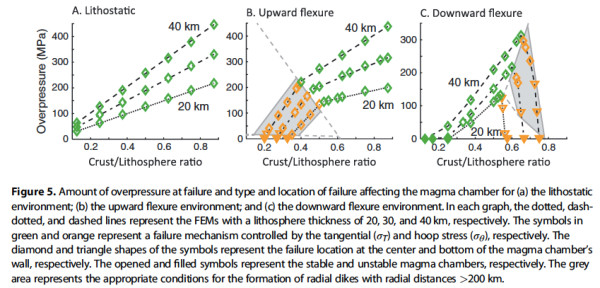
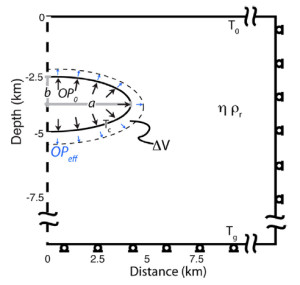 As molten rock ascends toward the surface of a planet it often stalls for a time, forming a shallow magma reservoir if the conditions are correct. When pressurized to the point of rupture, such reservoirs act to redirect magma laterally within the subsurface or can send magma on a path toward the surface again. Understanding the conditions that drive magma reservoir failure, and predicting the characteristic pathways followed by the magma that escapes, benefits from data gathered in the field, in the lab, and via analogue and numerical models. The latter have provided important insights in the last few decades, and they have also highlighted many areas where greater research is needed. For instance, how strong is the rock surrounding a reservoir, and what conditions exist there when a large (perhaps short-lived) magma body is present? Understanding these conditions is critical if we are to understand how much pressurization is required to initiate rupture — which in turn can help us understand when, and under what conditions, a given magma system might become hazardous to nearby populations.
As molten rock ascends toward the surface of a planet it often stalls for a time, forming a shallow magma reservoir if the conditions are correct. When pressurized to the point of rupture, such reservoirs act to redirect magma laterally within the subsurface or can send magma on a path toward the surface again. Understanding the conditions that drive magma reservoir failure, and predicting the characteristic pathways followed by the magma that escapes, benefits from data gathered in the field, in the lab, and via analogue and numerical models. The latter have provided important insights in the last few decades, and they have also highlighted many areas where greater research is needed. For instance, how strong is the rock surrounding a reservoir, and what conditions exist there when a large (perhaps short-lived) magma body is present? Understanding these conditions is critical if we are to understand how much pressurization is required to initiate rupture — which in turn can help us understand when, and under what conditions, a given magma system might become hazardous to nearby populations.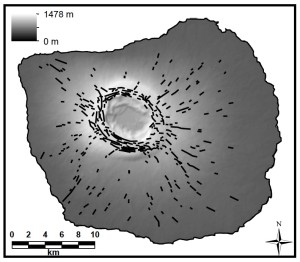 I am pleased to report that Shelley Chestler (’12) and I have just published her senior thesis research in the journal Geophysical Research Letters. Using numerical finite element models, and targeting Fernandina volcano (shown at right) as a case study, the article demonstrates how minor, volcanologically plausible variations in a magma reservoir system can lead to the intrusion of radial, circumferential, and corkscrew-style dikes akin to those that characterize many volcanoes in the Galapagos and elsewhere. This result is an exciting one, offering a solution to a problem that has puzzled geologists for some time, and complementing other recent edifice-modeling efforts (e.g. Hurwitz et al. 2009; Galgana et al., 2012) we have now identified conditions that can lead directly to lateral intrusion of radial dikes from a shallow magma reservoir.
I am pleased to report that Shelley Chestler (’12) and I have just published her senior thesis research in the journal Geophysical Research Letters. Using numerical finite element models, and targeting Fernandina volcano (shown at right) as a case study, the article demonstrates how minor, volcanologically plausible variations in a magma reservoir system can lead to the intrusion of radial, circumferential, and corkscrew-style dikes akin to those that characterize many volcanoes in the Galapagos and elsewhere. This result is an exciting one, offering a solution to a problem that has puzzled geologists for some time, and complementing other recent edifice-modeling efforts (e.g. Hurwitz et al. 2009; Galgana et al., 2012) we have now identified conditions that can lead directly to lateral intrusion of radial dikes from a shallow magma reservoir.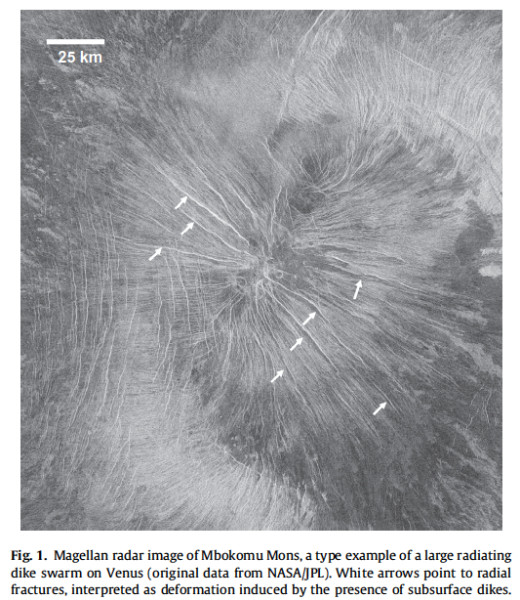 Giant radial dike systems that on average are several hundred kilometers in radius can be found on Earth, Venus and Mars. To date, however, it has been unclear how these impressive volcanic features might originate. For such systems to form, massive quantities of magma ascending from the mantle must encounter both a stress field that favors a radial dike configuration and something that redirects ascending magma laterally at shallow depths within the lithosphere. The former condition is straightforward to create via large-scale flexural uplift in response to plume impingement, underplating, or a similar mechanism; however, the stress state resulting from this process strongly favors continued ascent and eruption, inconsistent with evidence of long-distance lateral transport of magma through the radial dikes.
Giant radial dike systems that on average are several hundred kilometers in radius can be found on Earth, Venus and Mars. To date, however, it has been unclear how these impressive volcanic features might originate. For such systems to form, massive quantities of magma ascending from the mantle must encounter both a stress field that favors a radial dike configuration and something that redirects ascending magma laterally at shallow depths within the lithosphere. The former condition is straightforward to create via large-scale flexural uplift in response to plume impingement, underplating, or a similar mechanism; however, the stress state resulting from this process strongly favors continued ascent and eruption, inconsistent with evidence of long-distance lateral transport of magma through the radial dikes.